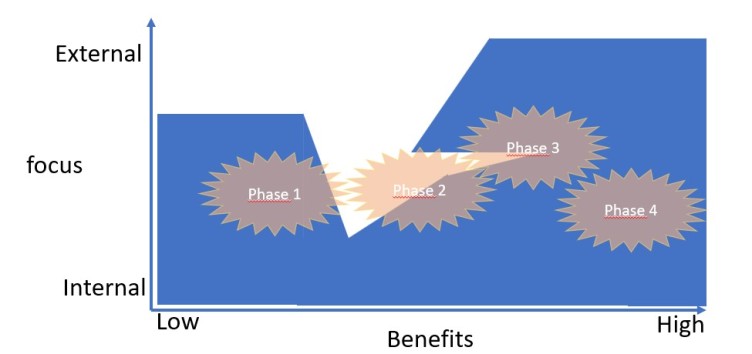(Generative) Artificial Intelligence (AI) has been a highly discussed topic since November 30th, 2022, just six months ago. For many organizational leaders, it presents a significant challenge in addressing the various questions and challenges it imposes on their respective sectors and organizations. I firmly believe that the path forward is in embracing this technology.
The fundamental question is whether AI is a disruptive technology or simply a fleeting trend. I am strongly of the view that it is disruptive. Consequently, it's essential to embrace it and convert the arising challenges into opportunities. Rather than putting many jobs at risk, individuals who fail to adopt this technology will find themselves overshadowed by those who do in their careers.
Goal : Get AI adopted in the Organization
A proposed structured approach to turning challenges into opportunities, which consists of four distinct phases. I believe that one should not reverse the order:

Phase 1: Learn, Absorb, Revise, and Communicate as Leaders
This phase centers around building your understanding of what this technology can offer. It involves an Outside-In approach (take some time and read about it), a thorough review of its impact on the strategic foundations (other topic : see earlier articles), and extensive communication and education for your teams. Importantly, in this phase, there should be no rush to find solutions.
Phase 2: Focus on Internal Use Cases
This phase involves focusing on internal use cases that primarily free up team members' time, allowing them to contribute to more valuable work. It will nurture the benefits for them personally. It involves a gradual internal adoption through the development of use cases and communication about the results. Also crucial are team training, experimentation, allowing room for failure, and iteration. Trust that your teams will quickly propose use cases and solutions - especially the early adopters within your organization. It's vital to give them a platform, nurture their ideas, and ensure that the use cases are addressed from people, technology, and process perspectives.
Phase 3: Gradual Exploration of AI in Customer-Facing Activities
The insights gained and the time saved from the previous phases will progressively free up capacity to start a similar approach towards customer-facing activities, products, and services. This phase should only start after some internal use cases and lessons learned.
Phase 4: Widespread Adoption of Technology and embedding in your operations and mission
In this final phase, the technology becomes widespread within the company. Both internal and external use cases will reinforce each other, resulting in a positive cycle of improvement and growth.
Through this systematic approach, one can ensure that the challenges posed by AI are not only addressed but also turned into opportunities that propel your organization forward.
As a starter a demysitfication : AI = Human assisting technology today
AI Isn't Here To Replace Jobs—It's Freeing People To Be People Again
at least that is also my point of view today.
This approach is not that different than any other change project: start with “the why” , build proofpoints (what’s in it for me) and then embed it in the organisation. Unfortunately this time, seen the rapid evolution, it is likely to occur on steroids 😉
Do share your thoughts!
cu stijn
ps : based on a sketch I created during a train ride this morning, I was able to draft an outline of my thoughts. I used ChatGPT to accelerated the drafting process for this article. Easy ;-)
